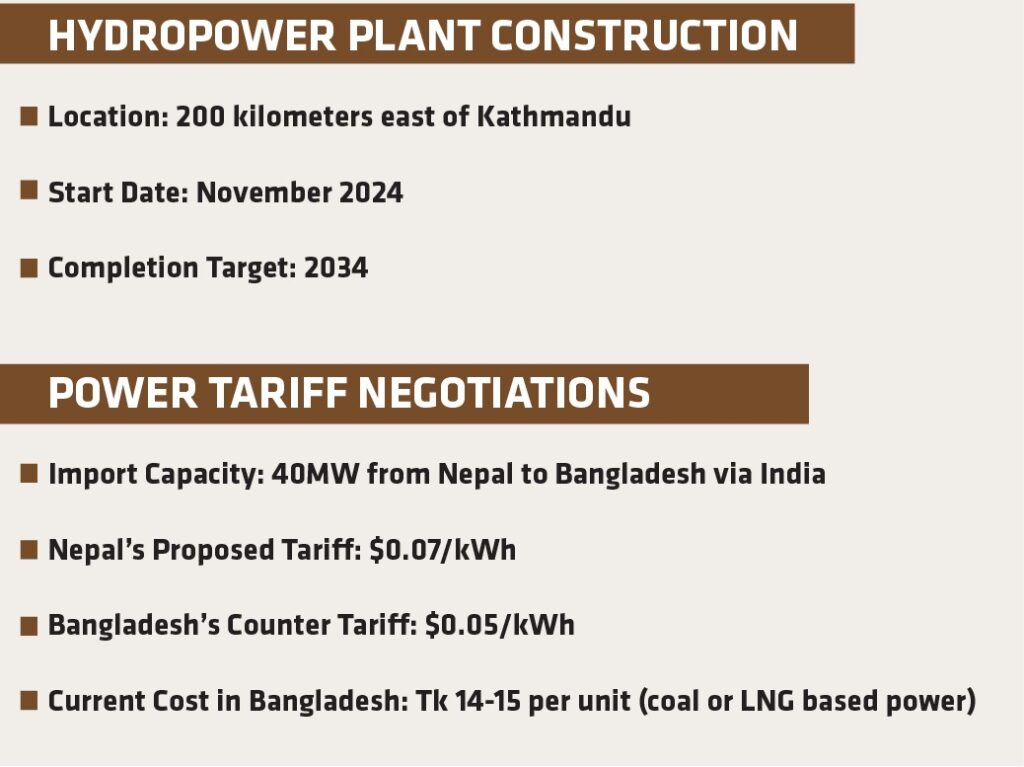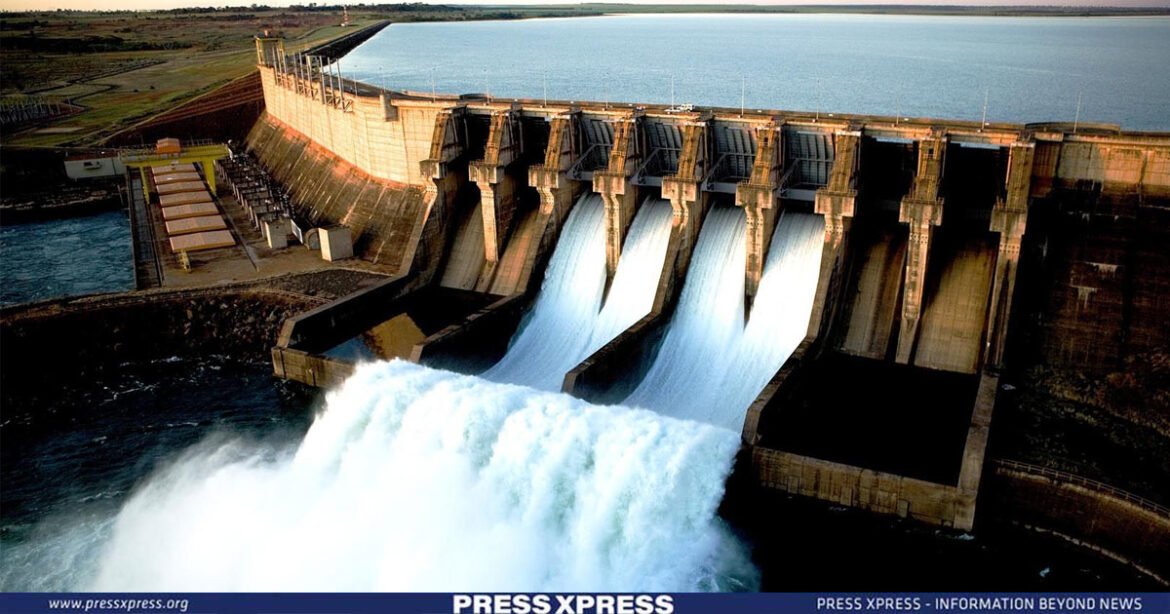Key Highlights:
- Bangladesh has been offered a new opportunity as Nepal prepares to commence construction on a new 1,040MW hydropower plant along the Arun River
- In 2023, the Government of India (GoI) consented to facilitate the transmission of electricity from Bhutan to Bangladesh via India
Bangladesh has been offered a new opportunity to explore the import of cost-effective electricity from Nepal shortly. This opportunity arises as Nepal prepares to commence construction on a new 1,040MW hydropower plant along the Arun River.
Nepal, seeking approval for the project, reached out to Bangladesh for their ‘no objection’ on December 28, 2023, following the World Bank’s requirements, which is partially funding the $1.9 billion Upper Arun Hydroelectric plant project.
Bhutan’s economy heavily relies on its hydropower sector, which contributes approximately 40% of its total revenue. With an installed capacity exceeding 2,300 megawatts (MW), Bhutan produces surplus energy, primarily exporting to India. Nepal, endowed with numerous rivers and rugged terrain, holds an estimated hydropower potential of 83,000 MW, yet only a fraction has been tapped into.
Meanwhile, in 2023, the Government of India (GoI) consented to facilitate the transmission of electricity from Bhutan to Bangladesh via India. Bangladesh’s initial import target from Bhutan stands at approximately 1,500MW of electricity. An agreement concerning this matter will be signed during the visit of the Bhutanese king on March 25th.

Nepal-Bangladesh Hydropower Deal Nears Finalization
The plant’s construction, located 200 kilometers east of Kathmandu, will begin in November 2024 targeting completion by 2034. Bangladesh is presently engaged in negotiations to determine the power tariff for its initial import of 40MW of hydropower from Nepal via India. Nepal has proposed a tariff of $0.07 per kilowatt hour (kWh), while Bangladesh is aiming for a lower tariff of $0.05.
The agreement for this 40MW power import is expected to be finalized before June 15. This proposed tariff highlights the cost-effectiveness of Nepal’s hydropower in comparison to coal or Liquefied Natural Gas (LNG) based power, which currently costs Bangladesh between Tk 14-15 per unit.
July 2023 saw Nepal’s electricity production surge to 10,536 GWh, a significant increase from the previous year’s 9,521 GWh, with a steady annual average of 1,243 GWh leading up to July 2023. The proposed Upper Arun Hydroelectric plant, with an optimal capacity of around 1,040MW, aims to ensure consistent energy supply domestically during dry seasons and facilitate clean electricity export to India and Bangladesh during monsoon seasons, according to the World Bank document.
The project marks the initial phase in a succession of initiatives aimed at bolstering the Sub-South Asia Power Pool. This collaboration will encompass Bangladesh, Bhutan, India, Nepal, and Sri Lanka, to enhance electricity exchange among these nations. As per the World Bank’s records, this project is the 2nd in a sequence of 5 planned hydroelectric projects along the Arun River.
The series begins with the Kimathanka High-Pressure Processing (HPP) at the China-Nepal frontier, which is currently in the design phase, followed by the ongoing construction of the Arun 3 HPP. Following this proposed project, the Arun 4 and Lower Arun HPPs are slated for planning further downstream. Earlier, in December 2023, Bangladesh expressed its interest in Nepal regarding the acquisition of 500MW of hydropower.

Bhutan-Bangladesh Ties Spark Hydroelectric Potential
In 2023, Bhutan boasted an installed power capacity of 2,343MW, with hydropower dominating the national grid by over 99%. In 2021, the country produced 11,059 gigawatt-hours (GWh) of electricity, with a significant portion (73.9%) exported to India. However, due to the lack of energy mix diversification, Bhutan faces the need to import electricity during low-water periods, affecting hydropower generation.
Forecasts from Bhutan’s Department of Hydropower Systems suggest that the country’s energy demand could reach approximately 25,270 GWh by 2030, necessitating a substantial increase in power generation capacity.
Both Bhutan and India have expressed commitment to enhanced sub-regional cooperation, particularly in the energy sector, as outlined in the proposed trilateral hydropower cooperation involving Bhutan, Bangladesh, and India. This cooperation aims to foster greater inter-linkages between the economies, benefiting all stakeholders involved.

Regional Hydropower Collaboration to Light Up Bangladesh
During the winter months of December, January, and February, Bhutan experiences a significant surge in electricity demand, whereas demand dwindles from June to September. Conversely, Nepal witnesses a peak in energy demand from January to February. Consequently, both countries, heavily reliant on hydropower, encounter capacity shortages due to water scarcity in the winter season.
In contrast, Bangladesh experiences a reverse pattern, with heightened energy demand from April to June and considerably lower requirements from November to February. Certain regions of India exhibit spikes in electricity demand from January to March or October to December.

Furthermore, Nepal boasts an economically viable hydropower potential of approximately 40GW, with only 5% currently utilized. Similarly, Bhutan possesses a technically and commercially feasible hydropower potential of 23GW, tapping less than 10% of its capacity. Conversely, Bangladesh faces hurdles in augmenting the proportion of renewable energy in its grid. Hence, the construction of new hydroelectric power plants in Nepal and Bhutan could facilitate Bangladesh’s endeavor to enhance its renewable energy share.
As Nepal and Bhutan move forward with their ambitious hydropower projects, the stage is set for transformative cooperation that transcends borders. The imminent agreements between Nepal and Bangladesh, as well as Bhutan and Bangladesh, mark significant milestones in this journey towards regional energy security and sustainability. By leveraging their complementary energy demand patterns and untapped hydroelectric potential, these nations have the opportunity to not only meet their own energy needs but also foster socio-economic development and environmental stewardship on a regional scale.
Renowned American author Helen Keller once remarked, “Individually, our capabilities are limited, but collectively, our potential knows no bounds.” This sentiment finds profound resonance within the South Asian energy landscape. The BBIN countries—Bangladesh, Bhutan, India, and Nepal—share strikingly similar socio-economic characteristics, presenting abundant opportunities for synergistic cooperation in the energy domain.


